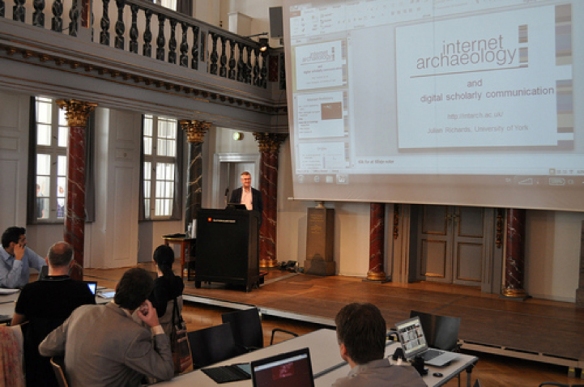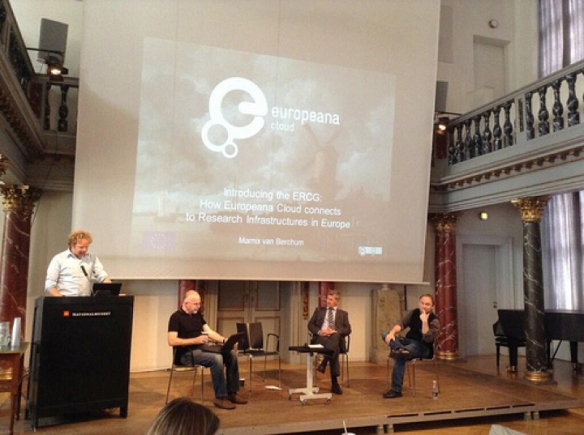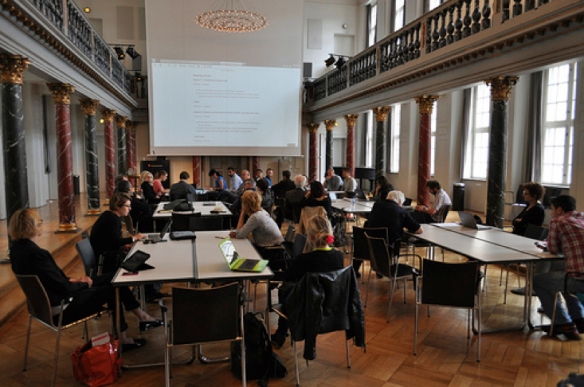Leipzig eHumanities Seminar, Leipzig, Germany
Date: 3:15-4:45 PM, Wednesday 23 October 2013
URL: http://www.e-humanities.net/events/2013-ehum-seminar-call.html
SLIDES OF TALK ONLINE AT: http://www.slideshare.net/nzerik/leipzig-ehumanities-23-october-2013-talk
Title: Interacting With History Using Virtual Environments
Where historians wish to develop digital environments to teach and disseminate, I suggest that the crucial issue is interaction and the learning that results from that interaction (Mosaker, 2001). In order to improve interaction, designers and historians could examine games and why they are so successful; a considerable amount of literature has argued that interactive engagement in a computer medium is best demonstrated by games (various references are provided in Champion, 2008). Although they are not easily customized for serious historical learning, game technology and online worlds are surprisingly advanced and span multiple platforms and devices, offering many opportunities for educational design. In this talk I will outline conceptual not technical issues in the development of these serious and pervasive games, outline a brief theoretical classification system, and provide examples of promising tools and interactive methods to help history and heritage scholars develop appropriate learning content.
Today, electronic games are an important vehicle for learning (Anderson, 2010; Dondlinger, 2007). At the minimum, a game is an activity that (1) typically has some goal in mind, something that the player works to achieve, (2) has systematic or emergent rules, and (3) is considered a form of play or competition (Oxford, 2010). While this encompasses “skill and drill” types of games, many of today’s digital games are much more complex, providing an interactive narrative in which the player must test hypotheses, synthesize knowledge, and respond to the unexpected (Dondlinger, 2007).
According to Ang (2008), a game can motivate the student via ludology or narrative or both. Yet there is still debate over whether the communication medium makes any meaningful difference in how well students learn (Jacobson, 2011). However, I believe that computer games and related media do have unique affordances for bringing history to life and can help historical narratives be experienced directly in the form of the game, or in a game-like environment. For evoking and communicating historical situations or heritage values I am interested in helping the player/user/student develop a deeper understandings rather than simply memorizing facts (Bloom, 1956). I wish to convey the cultural significance of what is represented and interacted with.
There are many examples of game engines and digital worlds for historical visualization, there are also explorative games where the historical information augments the experience, or is absorbed as an ambient medium. These projects have had some notable successes, but, arguably, important humanities-related issues are not being answered.
For example, can users learn via interaction the meanings and values of others, do we need to interact as the original inhabitants did? How can we find out how they interacted, and through the limited and constraining nature of current technology help interaction become more meaningful, educational and enjoyable (Handron & Jacobson, 2010)? How do we even know when meaningful learning is reached?
Scholarly knowledge does not easily translate to audience knowledge; nor is scholarly knowledge necessarily the type of knowledge that would best engage the public. And if we can use digital worlds for teaching and learning about heritage and history, is it preferable for the audience to learn about a collection of culturally situated past experiences, or a strictly academic procession of historical events? For example, Smith noted that there has been confusion between history as meaning the past, and history as being something produced by historians. Given that even philosophers such as Goldstein (1964) and Gale (1962) disagreed on what constitutes history and what constitutes recollection of the past; how can students or the general public reliably distinguish between the two? And even if we agree on what is the historical content, can we agree on how it can be or should be accessed?
Ideally, virtual environments may help the general public to create, and share and discuss hypothetical or counterfactual places, meet virtually in these places with colleagues to discuss them, work in these recreations to understand limitations forced on their predecessors, or develop experiential ways to entice a potential new audience to both admire the content and the methods of their area of research. However, these academic disciplines are typically book-based and do not see that an academic publication is also a simplification and metaphorical extension of the remains and ruins it describes.
So perhaps technology or evaluation is the not the fundamental problem. Skeates (2000) warned that archaeologists need to reconsider their field as a communication medium, and not just as a closed scientific discipline. For while these books presuppose a vast domain of knowledge, a certain learnt yet creative technique of extrapolation; they typically do not cover the experiential detective work of experts that visit the real site (Gillings, 2002).
Using media such as game engines to represent the past or digital places that represent the future, it is all too easy to be taken in by the lure of technology and forget to concentrate on enhancing the user experience. There is also a school of thought in archaeology that views digital media as purely a shop façade for the serious and scholarly past-time of reading and writing books (Parry 2005; Gillings, 2002). Yet if we avoid teaching with digital media, how will the changing attention spans and learning patterns of new generations be best addressed (Mehegan, 2007)?
Even if we decide on what we are evaluating, it is not clear how to evaluate. The ethnographic techniques used by researchers may be effective in recording activity, but they do not directly indicate the potential mental transformations of perspective that result from being subjectively immersed in a different type of cultural presence (Benford et al, 2002).
Conclusion
We lack digital history projects that are meaningful and engaging learning experiences. The conventions on how to play games are known to a wider number of people than frequent computer gamers, and these conventions typically provide engaging and challenging goals, strategies, and performance feedback which taken together help people to find some form of internal meaning and purpose in interacting with a virtual environment. In my proposed talk I will outline the major issues and sketch out possible solutions.
References
BBC Ancient History Section. (Undated). Death in Sakkara: An Egyptian Adventure, http://www.bbc.co.uk/history/interactive/animations/ironage_roundhouse/index.shtml
Benford, S., Fraser, M., Reynard, G. Koleva, B., and Drozd, A. (2002). Staging and Evaluating Public Performances as an Approach to CVE Research, Proceedings of the 4th international conference on Collaborative virtual environments, ACM New York.
Bloom, B. S. (1956). ‘Taxonomy of Educational Objectives’, Book 1 Cognitive Domain. New York: Longman Inc.
Champion, E. (2008). ‘Otherness of place: Game-based interaction and learning in virtual heritage projects’, International Journal of Heritage Studies, 14(3), 210-228.
Dondlinger, M. J. (2007). ‘Educational Video Game Design: A Review of the Literature’, Journal of Applied Educational Technology, 4(1), 21-31.
Handron, K., & Jacobson, J. (2010). Extending Physical Collections Into the Virtual Space of a Digital Dome,. Paper presented at the 11th International Symposium on Virtual Reality, Archaeology and Cultural Heritage (VAST), Paris, France.
Hight, J. (2006). ‘TEXT: Narrative Archaeology: reading the landscape’, newmediafix, http://newmediafix.net/daily/?p=638
Leader-Elliott, L. (2003). ‘Community Heritage Interpretation Games: A Case Study from Angaston, South Australia’, International Journal of Heritage Studies, 11:2, 161-71.
Gale, R.M. (1962). ‘Dewey and the Problem of the Alleged Futurity of Yesterday’, Philosophy and Phenomenological Research, 22(4), 501-511.
Gillings, M. (2002). Virtual archaeologies and the hyper-real, in P. Fisher, D. Unwin, (eds.), Virtual Reality in Geography (London & New York: Taylor & Francis, 2002), 17-32.
Goldstein, L. (1964). ‘The “Alleged” Futurity of Yesterday’, Philosophy and Phenomenological Research, 24(3), 417-420.
Jacobson, J. (2011). ‘The Effect of Visual Immersion in an Educational Game; Gates of Horus’, International Journal of Gaming and Computer-Mediated Simulations, 3(1), 13-32.
Mehegan, D. (2007). Young People Reading a Lot Less: Report Laments the Social Costs. The Boston Globe, 19 November (2007), http://www.boston.com/news/nation/articles/2007/11/19/young_people_reading_a_lot_less/.
Mosaker, L. (2001). ‘Visualizing Historical Knowledge Using VR Technology’, Digital Creativity S&Z 12(1), 15-25.
Oxford English Dictionary (2010). Retrieved December 17, 2010, from Oxford Dictionaries website: http://oxforddictionaries.com.
Parry. R. (2005). ‘Digital Heritage and the Rise of Theory in Museum Computing’, Museum Management and Curatorship, 20:4, 333-48.
Skeates, R. (2000). Debating the archaeological heritage, (London: Duckworth), 109-111.
Smith, B. G. (1995). ’Whose Truth, Whose History?’, Journal of the History of Ideas, 56(4): 661-668.









